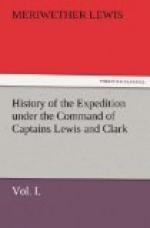Monday 17. The weather to-day was colder than any we had yet experienced, the thermometer at sunrise being 45 degrees below 0, and about eight o’clock it fell to 74 degrees below the freezing point. From Mr. Haney, who is a very sensible intelligent man, we obtained much geographical information with regard to the country between the Missouri and Mississippi, and the various tribes of Sioux who inhabit it.
Tuesday 18. The thermometer at sunrise was 32 degrees below 0. The Indians had invited us yesterday to join their chace to-day, but the seven men whom we sent returned in consequence of the cold, which was so severe last night that we were obliged to have the sentinel relieved every half hour. The northwest traders however left us on their return home.
Wednesday 19. The weather moderated, and the river rose a little, so that we were enabled to continue the picketing of the fort. Notwithstanding the extreme cold, we observe the Indians at the village engaged out in the open air at a game which resembled billiards more than any thing we had seen, and which we inclined to suspect may have been acquired by ancient intercourse with the French of Canada. From the first to the second chief’s lodge, a distance of about fifty yards, was covered with timber smoothed and joined so as to be as level as the floor of one of our houses, with a battery at the end to stop the rings: these rings were of clay-stone and flat like the chequers for drafts, and the sticks were about four feet long, with two short pieces at one end in the form of a mace, so fixed that the whole will slide along the board. Two men fix themselves at one end, each provided with a stick, and one of them with a ring: they then run along the board, and about half way slide the sticks after the ring.
Thursday 20. The wind was from the N.W. the weather moderate, the thermometer 24 degrees above at sunrise. We availed ourselves of this change to picket the fort near the river.
Friday 21. The day was fine and warm, the wind N.W. by W. The Indian who had been prevented a few days ago from killing his wife, came with both his wives to the fort, and was very desirous of reconciling our interpreter, a jealousy against whom on account of his wife’s taking refuge in his house, had been the cause of his animosity. A woman brought her child with an abscess in the lower part of the back, and offered as much corn as she could carry for some medicine; we administered to it of course very cheerfully.
Saturday, 22d. A number of squaws and men dressed like squaws brought corn to trade for small articles with the men. Among other things we procured two horns of the animal called by the French the Rock mountain sheep, and known to the Mandans by the name of ahsahta. The animal itself is about the size of a small elk or large deer: the horns winding like those of a ram which they resemble also in texture, though larger and thicker.




